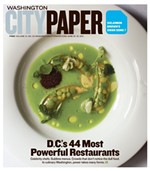Fables of the Deconstruction
As soon as word of Tristram Shandy: A Cock & Bull Story began circulating, a directive from the Movie Writers’ Guild decreed that the film’s source, 18th-century writer Laurence Sterne’s The Life and Opinions of Tristram Shandy, Gentleman, be described as “unfilmable.” But all novels are essentially unfilmable, save for examples of those contemporary genres—thrillers, chick lit, detective yarns—that tend to be merely screenplay treatments in drag. In fact, Sterne’s novel may qualify as more filmable than most: Its playfully self-conscious approach to narrative suits the many ways a winking filmmaker can frame a facetious tale. All of the book—615 pages in my Penguin English Library edition—can’t be put onscreen in 90 minutes or so, but its digressive tone can be amusingly simulated.
Tristram Shandy director Michael Winterbottom begins winking and framing from the very first, opening the film with actors Steve Coogan and Rob Brydon playing some version of themselves and discussing such vital issues—to actors—as tooth color and billing. Winterbottom and pseudonymous scripter Martin Hardy (apparently some amalgam of the director and regular collaborator Frank Cottrell Boyce) take the story backstage because that’s what Sterne did with his near-endless asides about the nature of storytelling itself. The point of the novel is never to get to the point, which the movie respects as best it can. Of course, its runtime is hardly long enough to exemplify Sterne’s trademark inertia.
Winterbottom previously filmed two dour Thomas Hardy novels, Jude the Obscure (as Jude) and The Mayor of Casterbridge (as The Claim). In keeping with his fetish for never repeating himself, the director did the first with BBC-style literalness but transplanted the second to the Sierra Nevadas. His third literary adaptation takes another turn: The principal precedent for Tristram Shandy (released in the U.K. under the leaner title of A Cock and Bull Story) is 24 Hour Party People, a semihistorical account of Manchester’s postpunk scene. As in that self-conscious romp, Steve Coogan is both the central character and the onscreen narrator, explaining the story as he acts it out. This time, however, there’s barely a story: Shandy observes the preparations for his birth as his father, Walter (Coogan again, outfitted with a fake nose), and mother, Elizabeth (Keeley Hawes), battle over where and how the not-so-blessed event should transpire. Meanwhile, Tristram’s uncle Toby fools with his pipe, recreates the Battle of Namur, and romances Widow Wadman (Gillian Anderson, the circumstances of whose midshoot arrival is one of the movie’s many inside jokes).
When the cameras supervised by onscreen director Mark (Jeremy Northam) aren’t running, “Steve Coogan” comments on the difficulties of casting the film-within-a-film—the boy who plays young Tristram is “the best of the bad lot”—contends with the visit of girlfriend Jenny (Kelly Macdonald) and their newborn child, and considers having a fling with Jennie (Naomie Harris), an earnest production assistant who’s the only film buff on the set. (She may also be the lone person here who’s actually read Sterne’s book.) Then there’s the matter of a one-night stand that “Coogan” had with a stripper who now wants to sell her story. To forestall this possibility, the actor must agree to an interview with an obnoxious journalist from the paper that’s been offered the story of his indiscretion. (Also arriving for an interview: the actual Tony Wilson, the man fictionalized by Coogan in 24 Hour Party People.)
Though Winterbottom forgoes the partially improvised approach of such recent efforts as In This World and 9 Songs, he does render Tristram Shandy as ramshackle as possible. The music is borrowed from various cinematic sources, including Michael Nyman’s score for Peter Greenaway’s The Draughtsman’s Contract and Nino Rota’s for several Fellini films. The humor encompasses battle re-enactors, Al Pacino impressions, and physical gags focused on Uncle Toby’s, young Tristram’s, and “Coogan”’s groins. The first two are derived from Sterne; the last, of course, is a latter-day addition. Indeed, as the script unravels—however intentionally—it also loses its connection to its source. The first half of the film maintains a superb balance between the novel’s japes and contemporary chuckles, although not without a certain predictability. (Anyone who’s read at least part of the novel will be unsurprised to see its famous black page become a black screen.) But then Sterne recedes and “Coogan” advances, and the movie begins to resemble a series of commonplace TV skits.
Tristram Shandy has been compared to numerous movie-set movies, from Day for Night to Irma Vep. But the closest match is Tom DiCillo’s droll but unenlightening Living in Oblivion, whose Chad Palomino (allegedly modeled on Brad Pitt) is a buffer, blonder equivalent of Winterbottom’s twitchy, needy lead. It was reasonably clever of the filmmakers to hit on pointless backstage intrigue as a modern equivalent of Sterne’s withholding style of yarn-spinning, but the movie lets that analogy take over, banishing the novel to the sidelines. Given the book’s style, that’s not an inherently bad place for it. If only the stuff happening on the field were more distinctive than the usual banter about what’s been left on the cutting-room floor. Sterne’s original fiction isn’t exactly a boffo comedy, but it’s funnier than “Steve Coogan.”

